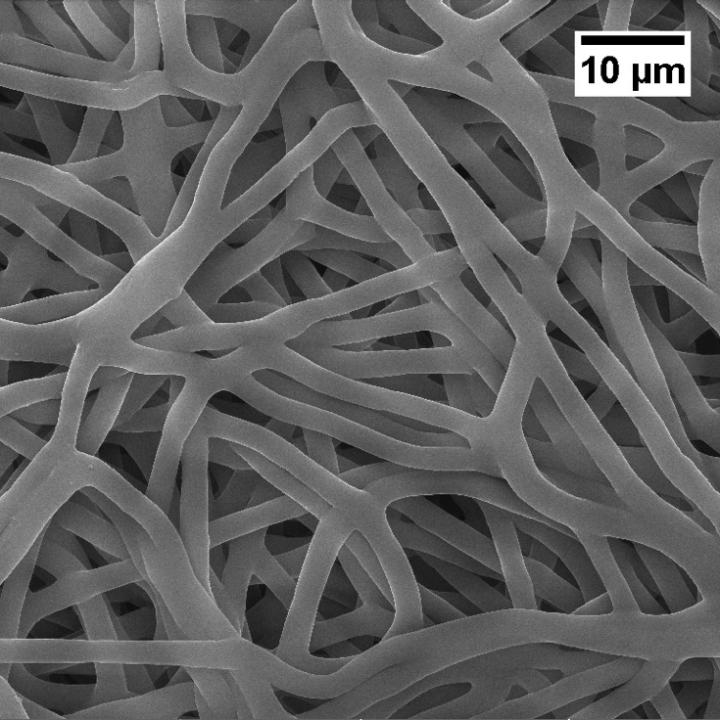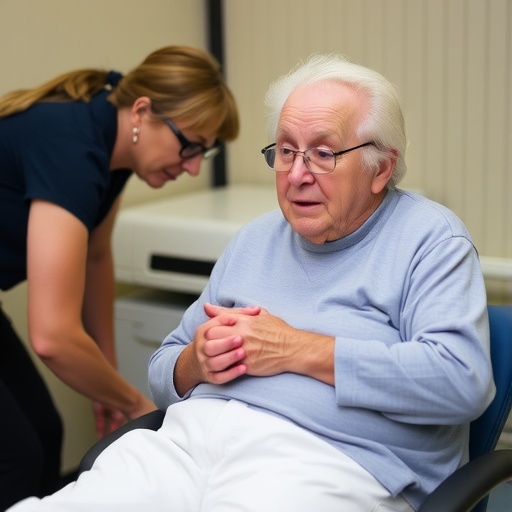Scientists of Tomsk Polytechnic University jointly with the University of Montana (USA) proposed a new promising material for regenerative medicine for recovery of damaged tissues and blood vessels.

Credit: Tomsk Polytechnic University
In this case, such an irritant is a regenerative material. According to scientists, the proposed solution is a simpler way to control the immune response compared to existing ones. The results were published in ACS Biomaterials Science & Engineering (IF: 4,511; Q1).
“Nowadays, researchers have only a few tools to regulate the immune response. You can work with proteins, but it is difficult. You can use compounds, capable of killing immune cells, but they are harmful to other cells.
We followed a different path and suggest using inhibitors placed directly in the material itself to recover damage.”
– Ksenia Stankevich, author of the article and engineer of the Laboratory for Plasma Hybrid Systems, says.
Scaffolds are 3D frames of thin polymer fibers interwoven with each other in different directions. In regenerative medicine, they are used in case of injuries of bone and soft tissues. They are placed in the damaged area and new tissue regenerates through the scaffold and fills the injured area.
TPU and the University of Montana used a biodegradable polycaprolactone polymer for their scaffolds. It makes products more flexible and affordable in comparison with alternatives. The scaffolds made of polycaprolactone were created by the method of electrospinning, producing thinnest fibers from a polymer solution under the electric field. At the stage of obtaining the scaffolds, we introduce inhibitors into the polymer structure. These are two compounds – IQ-1 (full name – 11H-indeno [1,2-b] quinoxaline-11-on oxime) and IQ-1E (full name – 11H-indeno [1,2-b] quinoxaline-11- on O-(O-ethylcarboxymethyl) oxime).
“Inhibitors suppress or slow down physiological and physicochemical processes. They affect enzymes. To do this, the enzyme and the inhibitor must fit together like a lock and a key. One of the groups of enzymes responsible for the inflammatory process is the JNK group” – Ksenia Stankevich explains. “Earlier we obtained new promising inhibitors, demonstrating high biological activity in inhibiting the functioning of these enzymes, such as IQ-1 and IQ-1E. Our scaffolds differ in the use of specific inhibitors and also in the fact that we can release them from the material gradually, having a prolonged effect. This is mainly due to the gradual natural degradation of the polymer. Additionally, it degrades to biocompatible 6-hydroxycaproic acid, which is recycled by human body.
Immune response of a cell is a cascade of biochemical processes. In this case, the JNK enzymes are links in the chain. Inhibitors bind to enzymes and block their work. Thus, suppressing one link, we turn off the entire subsequent reaction chain.
“In this article, we present the research results on immune cells, isolated from human blood and cell lines. In the future, we will look for opportunities for in vivo research.
Eventually, our scaffolds could be used to recover damages of soft tissues and blood vessels. The polycaprolactone has all suitable mechanical properties. For instance, it can reduce the negative consequences after a heart attack and stroke, the researcher says.
Scaffolds from various materials are already being implemented into medical practice in developed countries, but it is too early to talk about their widespread application. However, it is only a matter of time, that is why scientists continue searching for the most effective materials and biologically active compounds. ”
###
The present work is a result of the collaboration of several TPU research teams headed by Associate Prof. Sergey Tverdokhlebov, the Weinberg Research Center, Prof. Andrey Khlebnikov and Prof. Victor Filimonov, the Kizhner Research Center, and Prof. Mark Quinn, and Igor A. Schepetkin, Senior Research Associate at the Department of Microbiology and Immunology, the University of Montana.
The studies were conducted as the part of Ksenia Stankevich internship under the Fulbright Program and financially supported by the Russian Science Foundation project (No. 17-15-01111) and is a development of the RSF project No. 16-13-10239 – Development and Modeling of Hybrid Biodegradable Scaffolds with Predicted Physicochemical and Immunomodulating Properties for Tissue-Engineering Constructions
Media Contact
Vitalii Sdelnikov
[email protected]
7-382-260-6404
Original Source
https:/
Related Journal Article
http://dx.




